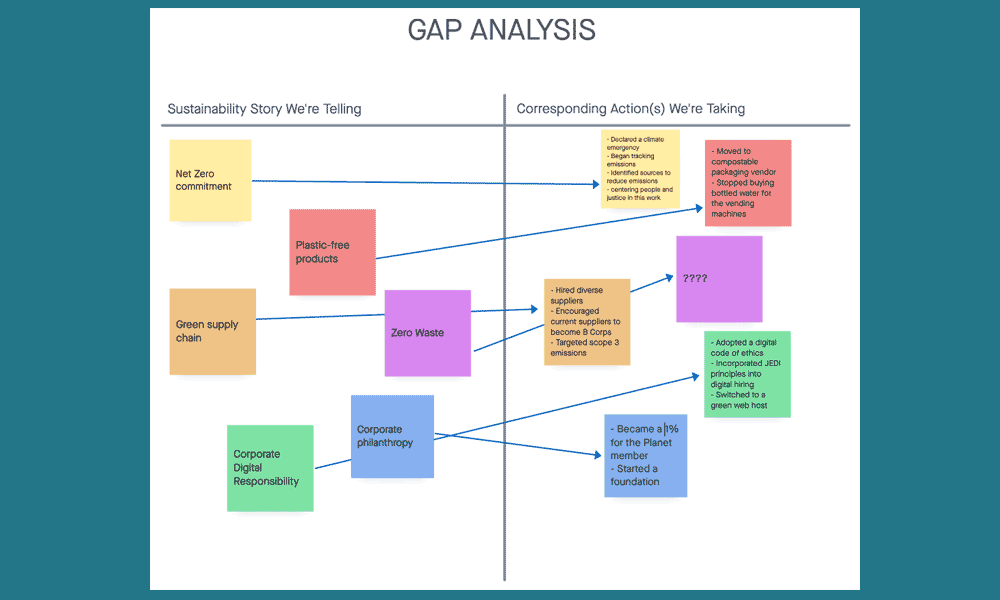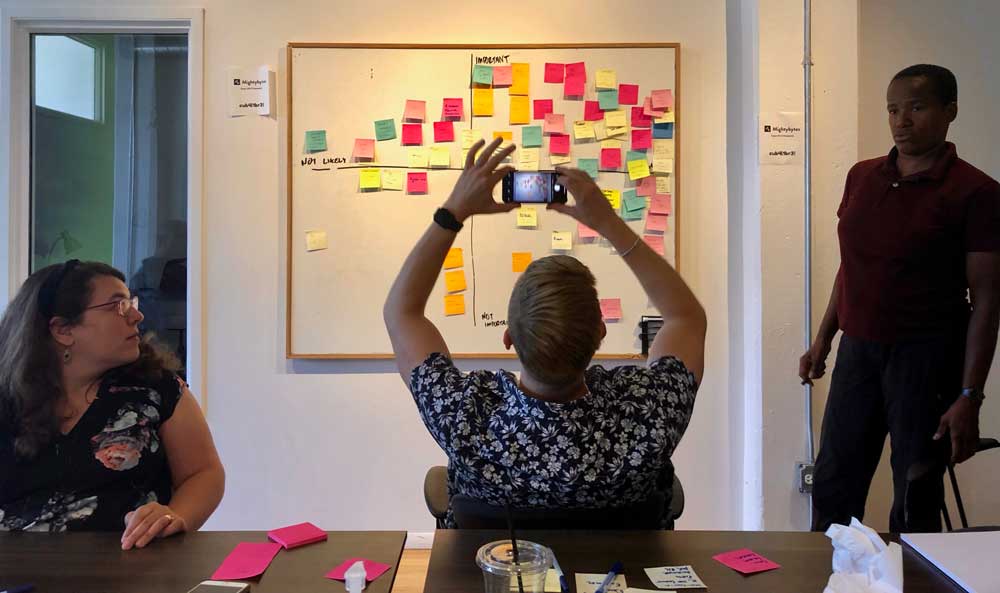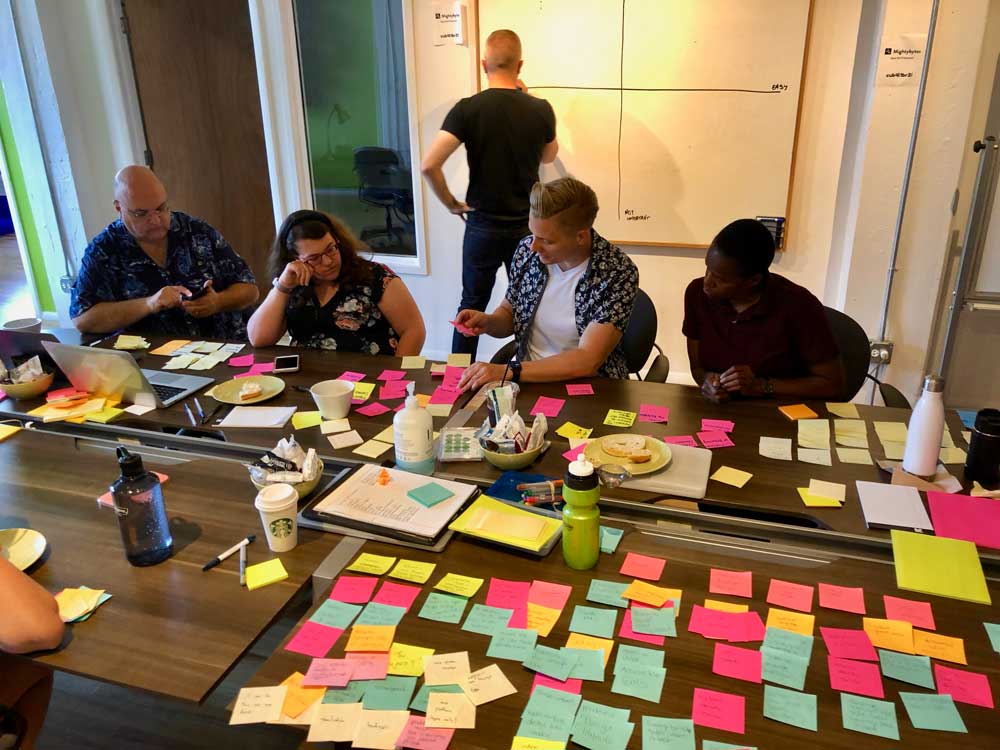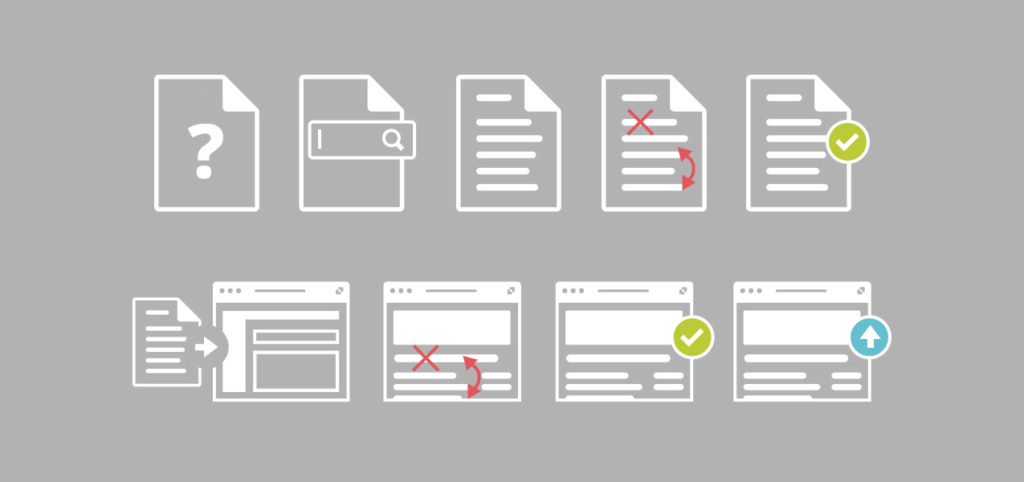Sustainability Storytelling Checklist [Free Download]

In this post, we outline how sustainability storytelling can bring shared value to your organization. We also break down a storytelling checklist to ensure actions align with words and you’re meeting stakeholder needs.
Sustainability stories are great brand-builders. However, if there’s a disconnect between the stories you tell and the actions your organization takes, they can also be a minefield.
We have compiled this checklist and the accompanying downloadable workshop deck to help organizations more effectively create, manage, and measure sustainability storytelling efforts. We hope you find these resources useful.
Do you Need a Sustainability Storytelling Checklist?
Telling your company’s sustainability story is more complicated than many people think. If you’re responsible for this, you often have more stakeholders to satisfy than other types of communications. Plus, while sustainability stories are commonly included in an organization’s marketing materials, they require input and actions from many internal and external stakeholders:
- Depending on the size of your organization, sustainability efforts require buy-in from leadership and often involve a far-reaching business ecosystem, from employees and contractors to individual business units, nonprofit partners, and possibly your entire supply chain.
- Investors increasingly use sustainability initiatives as a deciding factor for investments.
- “Raters and rankers” want sustainability data to understand risks and pressure companies to improve performance.
- Publicly traded companies are increasingly mandated—or at the very least, highly encouraged—to disclose ESG metrics by government agencies in a growing number of jurisdictions.
Also, the expanding definition of sustainability as Environment, Social, and Governance (ESG) factors complicates communications efforts. Often, a communications or corporate social responsibility (CSR) department alone is not equipped to handle sustainability storytelling in this complex environment.
A good checklist can help you:
- Identify and better understand stakeholder needs
- Outline a list of activities necessary to match story to action
- Chart a course of action to move your sustainability storytelling forward
Actions Before Stories
As important as stories are, the evidence to support them is far more important. Sure, sustainability disclosures are voluntary. They’re also under ever-increasing scrutiny. Action is the prerequisite for sustainability marketing and storytelling. It is also the overarching theme of our resources below.
These benefits underscore the importance of action and authenticity in sustainability storytelling:
- Shift perceptions: Great storytelling backed by real actions can change people’s minds about your company. This is critical in today’s fight for customers.
- Align products and services with the ESG issues you prioritize: Stakeholders can tell when sustainability is central to your business model, which is becoming the new bar for corporate sustainability. Plus, stories can either make this alignment shine brightly or cast a brand shadow when it’s missing.
- Improve relationships: If stakeholders can easily understand how sustainability is woven into your products and services they will give you credit for walking the talk. However, if they perceive more talk than action, it’s quite likely to backfire on you.
- Create shared value: Purpose, impact, and sustainability are driving business strategy at many organizations. This change presents an exciting opportunity to turn the tide on big social and environmental problems. It also brings a new set of challenges and questions, from reevaluating business models to figuring out how we might track hard-to-measure impacts.
Our Sustainability Storytelling Checklist
Below is a list of resources and potential actions you can take to improve your sustainability storytelling. Plus, at the bottom of this post, you’ll also find resources to improve your organization’s sustainability storytelling efforts.

1. Know your Audience
Before you can tell an effective story, you need to clearly understand who you’re trying to reach. As noted above, sustainability storytelling involves many stakeholders. Understand who is most relevant to each story you plan to tell.
Questions to Ask
- Who is most relevant to the stories we want to tell?
- What are their needs, behaviors, pain points, etc.?
- How might you validate your assumptions about each stakeholder?
- Why should they care?
Actions to Consider
- Proto-personas: Create consensus on demographics, behaviors, and pain points of your target audience. These are based on assumptions, so be sure to validate (or refute) them with additional research. Further reading: How to Create More Inclusive User Personas.
- Personal interviews: Learn directly what people want from your sustainability content. Learn more about facilitating effective interviews.
- Journey mapping: Understand the steps people take to interact with your brand and get what they need. Additional resource: Customer Journey Mapping Template.
Also, an effective organization is a customer-centric organization. Clearly understanding the needs of your customers and other stakeholders is an iterative and ongoing process. However, the leg work is always worth your effort in the long run.

2. Be the Story
Don’t just tell a sustainability story, live it. Otherwise, you run the risk of your integrity being called into question, or worse. This is no easy feat, so start small and don’t overstate your impact.
If your company already has a CSR department or sustainability strategy, that’s a good place to start. If not, learn what efforts you’re already taking, then align storytelling to those efforts. For Mightybytes, becoming a Certified B Corp helped us align our impact efforts with how we run our business and tell our sustainability story. This could be right for your organization too.
Most importantly, audit the other areas of your business to identify potential conflicts.
Questions to Ask
- Do you clearly understand the social and environmental impacts of your business model, products, services, programs, operations, etc.?
- Are you overstating the positive impacts?
- Check yourself: Are you making it sound like something related to operations is a big achievement?
Actions to Consider
- Gap analysis: Get stakeholders into a workshop to compare sustainability stories with the actual actions your organization takes. Do they line up? If not, create a roadmap for doing so. This can fuel your content efforts for years to come.
If you’re having trouble creating consensus on the sustainability storytelling problems you hope to solve, you might also check out our Problem Framing Workshop Template. That can help teams build consensus and create clarity around a specific problem.

3. Embrace Diverse Perspectives
Your sustainability stories will all sound the same if they are written by people with similar backgrounds. A diverse range of storytellers will produce a wider variety of stories that can appeal to different audiences. Tell your stories from non-traditional sources.
Related, good story structure can make or break your efforts to tell an effective and impactful sustainability story. Impactful stories have tension, details, colorful characters, and a narrative that raises the stakes in compelling ways. Clearly understanding the hero on each journey is critical to sustainability storytelling success (hint: It’s not your company).
Questions to Ask
- Who is the hero of each story? Who wins? Who loses? What’s at stake for you/them/all of us?
- Who is not represented in your stories and how they are told? How might you involve them?
- What are the roadblocks (tension) standing in the way of progress?
- What are the actions you’re taking to combat said roadblocks?
- What are the outcomes you hope to achieve?
- If you have achieved said outcomes, how does the data support your story? (see Numbers vs. Stories below)
Actions to Consider
- Stakeholder mapping: Map the key stakeholders in your business ecosystem and identify what matters to each of them.
- Identify the heroes: Center people at the heart of this work. Which stakeholders are critical on your sustainability journey so far? Who should be going forward?
- Craft the narrative: Use standard narrative structures to tell a compelling story that resonates with target audiences.

4. Engage Stakeholders
Understanding the stakeholders in your business ecosystem will help you identify ways to engage them in sustainability storytelling efforts. Each story might have a different set of relevant stakeholders. Each stakeholder may have different needs. Mapping them out can help you gain clarity. It can also help you identify where you need to bring more diverse perspectives into the mix.
Questions to Ask
- How do material sustainability issues impact my organization? My industry?
- Which organizational stakeholders are impacted by these issues? How might we engage them to take action?
- How might we prioritize stakeholder needs alongside our sustainability storytelling efforts?
- How might we create collective impact through actions, key partnerships, etc.?
Actions to Consider
- Understand materiality: What are the material sustainability issues that impact your industry and organization? More info: check out the SASB Materiality Finder to learn more about materiality in your industry.
- Rank stakeholder needs: Who is impacted by these issues? How might you involve them to improve performance?
- List actions: What can be done today? Next month? Next year? List and prioritize actions you can take to engage stakeholders in creating long-term positive social and environmental change. This will, in turn, drive more compelling sustainability stories.

5. Collaborative Storytelling
While writing is often a solitary act, sustainability storytelling is not. Plus, depending on your organization or industry, the stakes could be quite high. A single misstep could cost you.
People increasingly want to work for, buy from, partner with, or invest in organizations that share their values. Put processes in place to source, create, and approve sustainability stories with important stakeholders before they go public.
A good content creation workflow can include many steps and numerous stakeholders. Improve your content by creating easily accessible editorial guidelines and a clear content creation and approval workflow.
Questions to Ask
- Who is doing the most compelling work? Which teams are they on? What stories do they have to tell?
- What are the risks of publishing stories or data that aren’t true or are in conflict with other areas of our business model?
- What will you do if something goes wrong? What’s the contingency plan? How will you address disgruntled, disappointed, or angry stakeholders?
Actions to Consider
- Map Teams + ESG Efforts: Break down silos within your organization to foster new partnerships. This will lead to more impactful outcomes and more compelling stories.
- Identify “The Decider”: Who will ultimately be responsible for deciding which stories get told? Ideally, this individual has some authority and a clear understanding of ESG issues, the craft of good storytelling, and digital marketing.
- Create a Crisis Plan: You can’t predict the future. However, you can devise a communications plan should a crisis or unforeseen circumstances arise.
6. Numbers vs. Stories
Sustainability stories can contain a lot of data, some of which might be quite dry (though often no less important). Plus, some stakeholders want all the data while others may want very little. How do you balance good, clear sustainability data with effective storytelling?
Questions to Ask
- Which stakeholders are important to this story? What do they want from it?
- Is the story compelling? Does it have a clear narrative arc?
- Does it use data to support key points? If not, how might data make the story more engaging or compelling?
Actions to Consider
- Numbers: Understanding stakeholder needs will help you determine how much data to sprinkle into your stories. See Engaging Stakeholders above.
- Stories: Prioritize data when it makes a sustainability story more compelling. When possible, use data visualization to support storytelling.
- More Data: Make additional data easy to find for those who need it. This is especially important for transparent reporting and compliance.
If you want more information on compelling, data-driven storytelling, check out our post, How to Design a Sustainable Data Strategy or any of the Corporate Digital Responsibility posts on this blog.

7. Design for Usability, Findability, Accessibility
Next, put humans at the heart of all storytelling efforts. This includes how content is published, shared, or otherwise distributed.
For example, if your sustainability story is buried deep in your website or its content hidden in an 80-page PDF report, it won’t likely achieve the results you’re looking for. Once you create content, make it usable, findable, and accessible.
Questions to Ask
- Usable: How easily can stakeholders navigate, understand, and use your sustainability storytelling documents, reports, etc.?
- Findable: How quickly can different stakeholders find specific, relevant data and stories on your website, in your sustainability report, on social media, or anywhere else you share sustainability information?
- Accessible: How well can people with disabilities—up to one billion people around the world—engage with your content? Is it written in simple language? Is it walled off in an inaccessible PDF? Can it easily be read by assistive technologies?
Actions to Consider
- Usable: Audit the user experience (UX) of your content channels—website, social networks, and so on—to ensure they meet key criteria. Further reading: check out these five user research methods or the UX Design category of our blog.
- Findable: Improve content findability across all channels. More resources: get primers on content strategy, information architecture, or keyword strategy to help you improve content findability. Also, check out this blog’s SEO Strategy category.
- Accessible: Learn about the Web Content Accessibility Guidelines or check out the Accessibility category of this blog to learn some of the many ways you can improve the accessibility of content, campaigns, and your website overall.
Bonus: Tactical Storytelling Tips
Finally, here are some bonus tips that cover the tactical act of telling a good story. You can use these in any communications. They are not specific to sustainability storytelling.
- Avoid jargon: Sustainability stories typically need to appeal to a wide variety of stakeholders. Avoid industry-specific jargon, technical terms, or insider lingo. Instead, write stories your audience wants to read in simple, plain language that everyone can understand.
- Ditch the clichés: We’ve all heard them a million times: Yes, we know you’re committed to a better future. Repeating the same tired phrases over and over ends up sounding like word salad. Tell a better story. Better yet, as noted above, show don’t tell.
- Explain why: Share the motives behind your actions, which may seem obvious to insiders but could get lost on other stakeholders. Also, do so in your own unique voice.
- Make it tangible: Show the urgency. For many people “the future” is far away. How can you make it relatable and real for readers?
- Be specific: Details spark our imaginations. Don’t just say something is “sustainable” (another terribly overused term). Is your product made from organic hemp? Is it powered by renewable energy? Does it help to lift people out of poverty? Show us the attributes that make it so.
Sustainability Storytelling: Final Thoughts
Storytelling is an important yet complex part of your organization’s overall sustainability strategy. The most successful organizations holistically blend the actions they take with compelling stories to great effect.
Also, are you looking for more information on sustainability storytelling? Read our companion post, 7 Pitfalls to Avoid in Your Sustainability Story.
Finally, just want to get started? Here’s a handy version of this checklist in slide deck form. With the right stakeholders, you can use this deck to jumpstart your own sustainability storytelling efforts. Otherwise, feel free to reach out. We’re happy to help.
Special thanks to JD Capuano from our advisory committee for initial research on this post.
Digital Carbon Ratings, now in Ecograder.
Understand how your website stacks up against industry carbon averages with this new feature.
Try Ecograder


